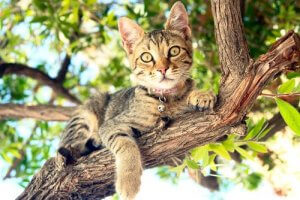What Is Environmental Enrichment?


Written and verified by the vet Eugenio Fernández Suárez
Whether exotic or domestic, it can sometimes be difficult to provide our pets with all the stimuli that they’d normally enjoy in the wild. One way to solve this is through environmental enrichment.
Although many domestic animals have evolved because of their close relationship with humans, the majority of the biological needs of a domestic cat or dog are still very similar to those of a wolf or wildcat.
To a greater or less extent, our pets spend their lives in captivity, without the freedom to go where they want when they want. In fact, most of their lives are spent in unnatural environments, that they’re not biologically adapted to.
This can have a huge impact on an animal’s well-being, affecting their lives on a physical and psychological level. This deprivation of liberty is often seen in exotic pets, and to a greater extent in farm animals.
Environmental enrichment is really useful for improving your pets’ well-being, and is the ideal way to reduce stress.
A lack of stimuli can not only have a negative impact on your pet’s welfare, but can also make living together more difficult. One example might be destructive behavior in dogs.
Promoting natural behavior
Environmental enrichment is all about improving our pets’ well-being by introducing new stimuli to their environment, and giving them the opportunity to express their natural behavior.

When we talk about natural behavior, you might think that something like your dog playing with a ball is unnatural. However, this isn’t exactly the case. Chasing and biting a ball is an expression of the typical hunting and play behavior observed in wild dogs.
However, there are many types of natural behavior that our pets often never experience. Many of them never have the chance to use all five senses in a natural and ever-changing environment.
So, while a ball or other toy is an example of environmental enrichment, this idea goes much further than just a few toys.
Environmental enrichment means improving the well-being of your animals, providing them with stimuli that will encourage them to express their natural behavior.
Getting the right environmental enrichment for your pet
There are a few simple rules you can follow to ensure you get the right environmental enrichment for your pet. These can be summed up as follows:
- Environmental enrichment must be species-specific: i.e. it should be adapted to the anatomy and behavior of that animal. For example, a scratching post to allow cats to sharpen their claws won’t be any use to a dog.
- Think about the established hierarchy: if you have several animals in your household and they often fight over food, you may find they also fight over any items you buy to provide environmental enrichment. As such, it’s important to provide them with several different options, as well as several food bowls.
- Be aware of any potential hazards: keep an eye out for any toxic elements or sharp objects.
Types of environmental enrichment
There are different types of environmental enrichment, depending on which behavior you want to encourage in your pet:
Natural enrichment refers to structural elements – whether in their cage or in your house – that promote natural behavior. One obvious example is scratching posts or cat trees, with platforms and tunnels for them to climb and explore.

You can also use dietary enrichment. This involves using toys that promote mental stimulation and encourage the animal to use its natural foraging or hunting skills. The idea is that if they have to work it, it’ll take them a lot longer to eat their food. One good example would be the popular rubber food toys, such as those sold by Kong.
Social enrichment aims to promote interactions between different animals, be it members of the same or different species.
Making sure our pets develop relationships with others is one of the most important types of environmental enrichment. This is especially true of social breeds.
Sensory enrichment encourages exploratory behavior, and involves stimulating the senses most commonly used by each species. In the case of cats, for example, you can stimulate their sense of smell using products such as catnip.
There are many different ways you can combine the different types of environmental enrichment. Try to look for ideas online, and adapt them to your pet. That way, you can be sure they’re entertained, and stress-free.
Whether exotic or domestic, it can sometimes be difficult to provide our pets with all the stimuli that they’d normally enjoy in the wild. One way to solve this is through environmental enrichment.
Although many domestic animals have evolved because of their close relationship with humans, the majority of the biological needs of a domestic cat or dog are still very similar to those of a wolf or wildcat.
To a greater or less extent, our pets spend their lives in captivity, without the freedom to go where they want when they want. In fact, most of their lives are spent in unnatural environments, that they’re not biologically adapted to.
This can have a huge impact on an animal’s well-being, affecting their lives on a physical and psychological level. This deprivation of liberty is often seen in exotic pets, and to a greater extent in farm animals.
Environmental enrichment is really useful for improving your pets’ well-being, and is the ideal way to reduce stress.
A lack of stimuli can not only have a negative impact on your pet’s welfare, but can also make living together more difficult. One example might be destructive behavior in dogs.
Promoting natural behavior
Environmental enrichment is all about improving our pets’ well-being by introducing new stimuli to their environment, and giving them the opportunity to express their natural behavior.

When we talk about natural behavior, you might think that something like your dog playing with a ball is unnatural. However, this isn’t exactly the case. Chasing and biting a ball is an expression of the typical hunting and play behavior observed in wild dogs.
However, there are many types of natural behavior that our pets often never experience. Many of them never have the chance to use all five senses in a natural and ever-changing environment.
So, while a ball or other toy is an example of environmental enrichment, this idea goes much further than just a few toys.
Environmental enrichment means improving the well-being of your animals, providing them with stimuli that will encourage them to express their natural behavior.
Getting the right environmental enrichment for your pet
There are a few simple rules you can follow to ensure you get the right environmental enrichment for your pet. These can be summed up as follows:
- Environmental enrichment must be species-specific: i.e. it should be adapted to the anatomy and behavior of that animal. For example, a scratching post to allow cats to sharpen their claws won’t be any use to a dog.
- Think about the established hierarchy: if you have several animals in your household and they often fight over food, you may find they also fight over any items you buy to provide environmental enrichment. As such, it’s important to provide them with several different options, as well as several food bowls.
- Be aware of any potential hazards: keep an eye out for any toxic elements or sharp objects.
Types of environmental enrichment
There are different types of environmental enrichment, depending on which behavior you want to encourage in your pet:
Natural enrichment refers to structural elements – whether in their cage or in your house – that promote natural behavior. One obvious example is scratching posts or cat trees, with platforms and tunnels for them to climb and explore.

You can also use dietary enrichment. This involves using toys that promote mental stimulation and encourage the animal to use its natural foraging or hunting skills. The idea is that if they have to work it, it’ll take them a lot longer to eat their food. One good example would be the popular rubber food toys, such as those sold by Kong.
Social enrichment aims to promote interactions between different animals, be it members of the same or different species.
Making sure our pets develop relationships with others is one of the most important types of environmental enrichment. This is especially true of social breeds.
Sensory enrichment encourages exploratory behavior, and involves stimulating the senses most commonly used by each species. In the case of cats, for example, you can stimulate their sense of smell using products such as catnip.
There are many different ways you can combine the different types of environmental enrichment. Try to look for ideas online, and adapt them to your pet. That way, you can be sure they’re entertained, and stress-free.
This text is provided for informational purposes only and does not replace consultation with a professional. If in doubt, consult your specialist.








